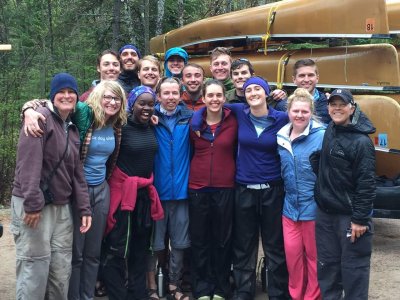A classroom in a canoe: GC students spend May term on the Boundary Waters

While most GC students spent their May term in classrooms, labs or studios, 13 students embarked on a self-contained canoe trip in the Boundary Waters Canoe Area (BWCA).
This trip marked the tenth year that Associate Professor of Kinesiology Val Hershberger has led students to the Boundary Waters, with help this year from 1993 Goshen College alumnus Gretchen Nyce, as well as Wilderness Wind Camp staff member, Molly Bontrager.
“I haven’t been in a class that challenges everything about you; physically, mentally, socially, spiritually and emotionally,” said sophomore music major Charlie Ostergren, of Goshen. “Being on the water gave me a peaceful and reflective time away from my busy schedule.”
The first three days of the class were spent at a base camp formerly known as Wilderness Wind (now owned by Chicago Voyagers), a camp nestled beside the Boundary Waters Canoe Area Wilderness, near Ely, Minnesota, doing voluntary service and preparing to go out onto the water. This preparation involved studying the history of the area, the people, geography of the region and animal and plant extinction, as well as practicing canoe paddle strokes, canoe rescue, reading a compass and understanding a map, packing food for the week, using a camping backpack, tying ropes and other useful skills that would aid in the safety of each student.
According to Hershberger, the class helps students gain an appreciation for the art and the skill of canoeing and a respect for water travel, adjusting to weather conditions and environmental concerns. Some of the topics that were covered they covered were wilderness ethics, wilderness first aid, canoeing skills, the “Leave No Trace” principle, and safety and rescue skills.
“People traveled like this for years,” said Hershberger. “I find it to be a humbling experience, whereby we are not in control of anything that comes our way. Nature has the upper hand in this case.”
Many of the lakes are connected by a series of trails called portages. Here students got a chance to experience the challenge of hauling gear and canoes over small ridges that overlook the lakes, some as long as a mile and a half.
“Our trip began on the Little Indian Sioux River and we paddled up in Lac La Croix area for several days. We visited the Indian pictographs and Warrior Hill,” said Hershberger. “In this trip we canoed between 40-45 miles total.”
Following the BWCA rules and regulations of no more than nine people and four watercrafts together in the wilderness, the students were divided into two groups. Each group was responsible for their gear and food and scouted for campsites separately.
“There were many times that we met up with the other group, including our layover day that we go to spend together,” said Hershberger.
Students worked on projects throughout their time in the Boundary Waters, which they then shared with the larger group at the end of the course. In addition to research papers, students could also opt for an interdisciplinary learning project that pulled from their diverse academic backgrounds. Projects ranged from photography and poems to short stories and research papers about mushrooms.
“We had an exceptional group of students this year,” Hershberger said. “They were fun, cooperative, collaborative and were an excellent singing group.”
By Achieng Agutu




